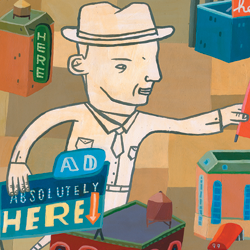An exhibit past its prime can be a costly eyesore. But before tossing out your tired display, try to resuscitate it in time for your next show. By Candy Adams

et's face it – exhibits don't last forever. And even though the economy has been slowly improving, not every exhibit manager has a bulging budget that will support a new build. So what can you do when your exhibit is in need of a facelift?
You need to objectively weigh the practical and aesthetic value of the makeover versus the total cost of the project. In reality, many of the aesthetic exhibit overhauls I've managed in my career were due to a change in company ownership or corporate branding. Therefore, they've required new color schemes and logos, but not necessarily a whole new property. In fact, I've found that as long as the exhibit's framework is structurally sound, transforming old exhibit properties with a new skin can be very feasible, both visually and financially.
With that in mind, here are tips and tricks to help you keep an exhibit looking fresh without putting your budget on life support.
Routine Maintenance
It's almost impossible to avoid normal wear and tear, regardless of how careful your exhibit house packs your properties or how diligently your booth staffers and installation-and-dismantle crewmembers handle the components. So your exhibit is probably going to get a few bumps and bruises along the way.
The key to keeping an exhibit in perfect form is identifying potential issues early and often. First, ask your I&D crew to point out any repairs that can't be accomplished on site and/or during installation. These repairs can be noted on the master blueprints and with photos that can be emailed to you. Then, share the photos with your exhibit house.
Second, schedule a visual inspection by your exhibit house as soon as the booth arrives after a show but before it is placed in storage. That way, any cleaning, touch ups, or repairs can be made at a more leisurely pace – and hopefully not at rush or overtime rates – rather than waiting until the exhibit needs to be shipped to the next show.
These types of minor repairs can include things such as fixing doors that don't lock properly or addressing laminates that are chipped, loose, or bubbled. If you have tensioned-fabric walls or hanging signs, have the integrity of the seams inspected for areas that may have been stretched too far and popped. Your exhibit house can also inspect and clean your carpet before it goes into storage, giving it plenty of time to dry in its warehouse and thus preventing delamination of the backing. Have any mounted graphics checked for dog-eared edges that need to be trimmed or replaced. Staying on top of these little upkeep issues can extend the life of your exhibit and ensure its functionality.
Also take a good, hard look at your shipping containers. When the wooden planks (aka skids) fall off crates, pallet boards crack or collapse, and rolling cases lose their wheels, your exhibit becomes susceptible to damage. Inspecting the inside of your crates and cases is important, too, especially if they contain jigging that secures your exhibit components or foam lining to protect audiovisual equipment. If the needed repairs go beyond replacing wheels and adding new skids, then consider purchasing new crates and cases. The cost of replacing them can be less than the price of a new exhibit.
Exhibit First Aid
Not every scrape and scratch warrants a trip to the exhibit house for repairs. In fact, you can fix minor damage to your exhibit structures on site – as long as you have a well-equipped gang box. For cosmetic fixes, I pack touch-up paint, small paintbrushes, and Q-tips. Before each show, I check my touch-up paint to make sure it hasn't dried up and turned to stone. If you don't have paint, pack some Sharpie markers that match the laminate and/or wall panels in your exhibit. They come in nearly every color and make for a quick fix on the go.
Sometimes, an exhibit isn't banged up so much as it is dirty. To clean up laminates, I use any kind of "goop" remover I can get my hands on, such as WD-40, along with no-scratch sponges. I like Mr. Clean Erasers as long as you have access to water since they need to be damp to work. These items will take care of any leftover adhesive from hook-and-loop fasteners. Other must-have supplies include no-streak cleaners, polishers, and lint-free rags. I'm a fan of aerosol cans (such as Sprayway Glass Cleaner) that won't spill in the gang box, and Novus polishing products that work on buffing scratches out of plastics, laminates, and acrylics.
When it comes to booth carpet, I recommend packing some Folex Carpet Cleaner and a few small terry cloth towels. This combination will also work to remove spots on any fabric furniture. I also pack a 10-inch wide lint roller with a 3-inch extendable handle that picks up just about anything. My favorite is the Evercare Mega Cleaning Roller – it won't even get you in trouble with the unions who claim jurisdiction over vacuuming. And don't forget a long-handled antistatic duster for the dust that clings to your exhibit, especially after the aisle carpet is laid.
Beyond Repair
If your exhibit needs more than a trimmed dog-ear here or a colored-in scrape there, then it's time to consider refurbishment. Refurbishing an exhibit property doesn't necessarily mean a major makeover or overhaul, but generally includes changes or additions to an exhibit that will increase the functionality or enhance the look of the structure. Brainstorm with an exhibit house to determine improvements that fit your current exhibiting strategy and budget, and keep in mind that not all the changes have to be made at once. They can be rolled out in phases as your cash flow and show schedule allows.
Some modest modifications might include replacing older halogen lighting with cooler and more energy-efficient LEDs, switching out stem lights for backlit fixtures, adding lights to hanging signs for increased visibility, updating corporate ID headers or product signage on kiosks, and upgrading furnishings in meeting rooms, theaters, and conversation areas.
If you need something more extensive due to a corporate merger, rebranding initiative, product launch, etc., consider changing the entire color scheme of your exhibit including carpet, walls, graphics, and hanging signage. You can also make a big visual impact by ditching heavy wood wall panels in favor of framed fabric where possible, placing stretchy fabric covers over existing panels, and refacing hard walls with new laminate or covering them with applied digital graphics, vinyl, or fabric.
Assuming you have the funds, add new elements such as touchscreen kiosks, meeting rooms, storage areas, product displays, or even an upper deck, and replace static graphics with digital graphics on flatscreens. Finally, don't forget the flooring. For an easy update, swap out worn carpet for new wood laminate or vinyl.
Make it Work
And now for the low-cost option: reconfiguration. If the bones of your exhibit are decent and the aesthetics are up to par, but you just want a different look, simply rearranging the current components of your display – and possibly adding a few purchased or rental pieces – can give you an exhibit that adapts to changing booth sizes and markets.
For example, if your booth space has grown and your exhibit hasn't, rent additional properties to fill the gap. This could be anything from adding meeting room walls and increasing the amount of seating in a lounge area to adding more demonstration kiosks. Some exhibit houses even offer rent-to-own programs if you don't have funds in your current budget and can amortize the spending for a few new exhibit components.
The Last Resort
There may be times when nothing is going to work to bring your exhibit back to life, and someone just needs to bite the bullet and sign its death certificate. If your exhibit is 1) excessively bulky to ship, 2) heavy to dray in and out of the hall, 3) expensive to install and dismantle, or 4) gives the impression that your company is on its last financial leg, it's time to say "Goodbye" and pull the plug. But don't despair – putting an old exhibit out of its misery just might breathe fresh air into your exhibit program.




 et's face it – exhibits don't last forever. And even though the economy has been slowly improving, not every exhibit manager has a bulging budget that will support a new build. So what can you do when your exhibit is in need of a facelift?
et's face it – exhibits don't last forever. And even though the economy has been slowly improving, not every exhibit manager has a bulging budget that will support a new build. So what can you do when your exhibit is in need of a facelift? 



